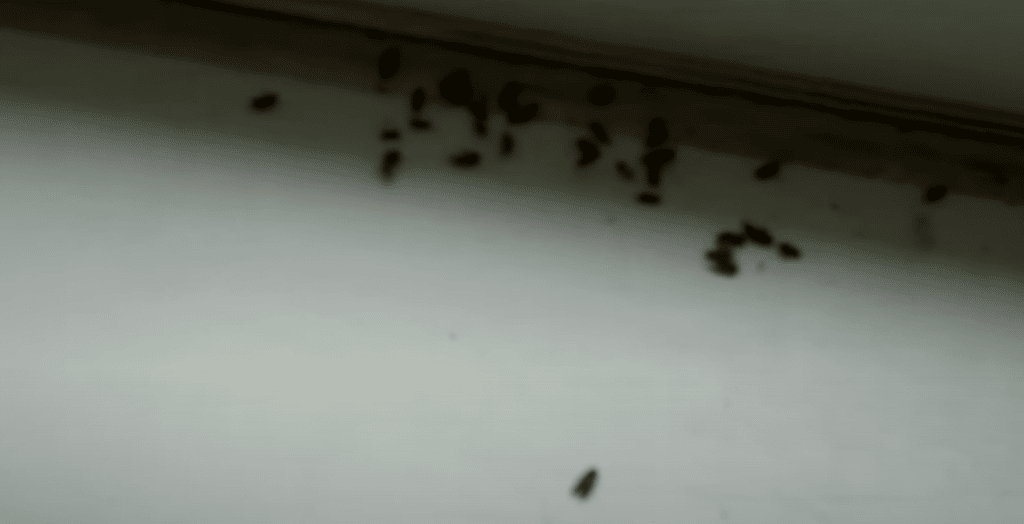Active Woodworms?
The thing about woodworms is that eventually the little grubs eating the wood mature. Then they turn into beetles and emerge to complete their life cycle. This is what leaves the characteristic woodworm holes in the surfaces of infested wood. These may be obvious, or not. Sometimes the ‘flight holes’ are in parts of the timber that cannot be easily seen. Perhaps below a floor, behind cupboards or in a roof void.
So how do you know if you have active woodworms?
There are three main methods:
- Finding live beetles flying around the house or walking on surfaces
- Seeing new flight holes appear where you are sure there were none before and,
- Finding fresh ‘frass’* either around flight holes or for example, lodged in cobwebs
Our Technical Director Bryan Hindle has completed thousands of timber and damp surveys over his long career. He’s not a cinematographer though and his video skills lack something in the way of production values. However, the above video is very useful for anyone with even a passing interest in woodworm. It will also benefit other surveyors, who might wish to pick up a tip or or two, from a real woodworm expert.
Read on for the details you need. If you’d rather just pick up the phone we are friendly and helpful – call us no on Leeds 265 2752 York 566577 or Sheffield 224 5121 or email us via our contact page
Window sills
Most houses have a lot of wood in them. A good way of looking for active woodworm is to carefully and diligently inspect every bit of wood in the house. This takes time and cost money. We do this every day, but of course, over the years a good damp and timber surveyor will accumulate various strategies. Strategies designed to save him time and help his work.
This is why our timber surveyors always look in the window sills of houses. We do this in the summer months and other times of year if the house has been left unoccupied for a long period.
When an adult Common Furniture Beetle emerges it needs to find a mate. It will crawl around the infested area and it may get lucky. If it does so, the female will often lay her eggs in small cracks in the wood. Perhaps she’ll lay them in an old flight hole, maybe even the one her suiter emerged from. If love is more elusive, the beetles take to the wing and fly off is search of it. Thus in a houses with a moderate of heavy infestation (where there will be lots of adults emerging), the windows will act as a barrier to their escape.
The adults don’t live long. They don’t feed or drink or anything. They are merely mating and egg laying machines. The video shows that in the case of this house, which has been empty for a few weeks up to summer. The window sills are full of dead adult woodworm. This is great because of course our surveyor always checks. On seeing the woodworm carcasses, he knows with near certainty, that there is a sizeable woodworm infestation here.
The role of moisture in cases of active woodworms.
Woodworms don’t know what a floorboard or a roof truss is. A bookcase or a staircase is nothing to them. Wood is just a food source, which they have evolved to exploit. Luckily for us, they evolved in the forest, fulfilling their role as assistants in the recycling of the energy stored in dead timber.
Let’s imagine the conditions inside a dead log on the forest floor, for a moment or two. It’s cold in there. The wood is resting on a bed of half-rotted leaves, full of woodlice and ants. More leaves are piled on top of it. These are wet; we’re in Yorkshire!
The first recycling crew on duty are the spores of various fungi. These begin the process of injecting enzymes to break down the cell walls. If it’s summer, insects will start laying eggs, both on the surface and in some cases into the bark and down the end of the vessels and pores in hardwoods. The sapwood, with its rich layer store of sugars is most attractive. In fact eventually the wet wood is in an advanced stage of decay and all of the insects are having a field day…. This is woodworm heaven (in the Disney animated film ANTZ – they called this sort of place insectopia).
Now picture a piece of stale bread. Dried out and crisp. You could live on that; if you call that living. To active woodworms, this is the equivalent of floorboards in a warm, centrally heated house. It is the same material as the tasty moist log on the forest floor; bread without jam, tea without a biscuit and tonic without gin.
This is why houses are not usually consumed by woodworm within years of construction. Think about it. If you built a house in the forest and forgot the roof, how long would it be before the timbers were rotting and falling apart? Would it take five years, ten or longer? House are built of tasty timber but kept dry, they last decades or more.
The above conditions ensure that in houses, active woodworm infestation is a slow motion destroyer. It is no longer the quick recycling machine of the forest. We’d go as far as to say that the baby active woodworms have been sold a lemon by their lazy parents. Doomed to eat dry bread and be desiccated by central heating. It’s a tough life.
They are tough though; woodworm. They can get along just fine, even at quite low moisture contents. Low for a house is around 13% or so. However, only a few percent points more and life gets much rosier for active woodworms (say 20%). Add a few more points and fungi get involved too (25% plus). Suddenly we’re back in insectopia again. These conditions mean faster growth to adulthood, more eggs, higher survival rates and more damage.
This is why damp and timber go together. A damp and timber surveyor will search for sources of moisture. Once he finds these he will be aware that any structural timbers in that environment are at higher risk of infestation. That infestation is also likely to be in robust health.
Want more juice on woodworm? read on or call our woodworm experts for free advice or, to book a timber survey Leeds 265 2752 York 566577 or Sheffield 224 5121 or email us via our contact page
Frass and rust
In the video the carpets have been pulled back in the rooms and the timber floor is accessible. If you look you can see some small yellowish stained smudges on Bryan’s badly focussed images. These are woodworm flight holes. The smudgy nature is due to the carpets being dragged on them. The colour is typical of the frass of common furniture beetle Anonbium punctatum.
On the subject of damp, note the rusty nail heads in the floorboards. In a dry house, they could have a slight bit of rust after a decade or two. However, these have a halo of stained wood around them, where the products of corrosion have leached into the wood. The stains generally follow the grain because that is how wood works; the fibres are designed to transport water up the tree; along the grain; not across it. Stains suggest more water than normal. More moisture delivers better living conditions for the woodworm. It is not only active woodworm; it’s very happy woodworm too.
The cause of the high moisture content could vary. It could be rising damp; penetrating damp; condensation maybe? In this case it is simply the end result of poorly ventilated sub-floor voids. The airbricks around the house, at the base of walls are few in number. They are obstructed by cobwebs and other detritus. This means the floorboards have a moisture content of over 18% on the surface. It is between 20% and 24% in the joists. These levels are common in older house ground floors, where the ventilation is poor. Want to know more about moisture meters and timber? Here’s a guide on that.
Woodworm treatment.
The floor in the video is beyond help. The floor boards have a high sapwood content (often the case with smaller section timbers like boards), as you can see they are reduced to sawdust. The joist fared slightly better, with some naturally resistant heartwood present. However, they had higher moisture content, which active woodworms love. Early stage decay by wet rot was appearing in some joists. Thus even the heartwood was infested. The floor was removed and replaced in its entirety.
Other timbers in the house were in varying stages of repair. Careful probing with a screwdriver allowed some timbers to be saved. Those that were salvageable were treated in-situ, using a safe micro-emulation based insecticide (Soluguard). The roof was also infested, though thankfully there was no structural damage. Soluguard was chosen here, after the loft was emptied of insulation for inspection and thorough treatment.
The sub-floor ventilation was improved to bring down the moisture content of the timbers. This involved replacing all of the air bricks with larger more efficient items and installing some additional ones too. Care was taken to make sure that the sub-floor void dividing walls allowed a through draft.
We hope the video and the description above is helpful. If you suspect you may have a problem, our woodworm experts are available to help.
If you are buying a house, our damp and timber surveyors can be relied on to carry out a thorough timber infestation survey for you. Our reports are written in plain English and are relied on by lenders, homebuyers and vendors too.
For a non-residential commercial woodworm service, please transfer to our commercial woodworm pages. To book a homebuyer survey or have a chat with our friendly and knowledgeable team call us Leeds 265 2752 York 566577 or Sheffield 224 5121 or email us via our contact page
Any clients who are passing our Sherburn in Elmet office are welcome, to come and have a look and feel of some frass. Frass and timber of many kinds, infested by different insects, including active woodworms, is kept in the office for training reasons (and also because our technical director is a woodworm nerd).
*Frass is the generic name for the faecal matter produced by wood boring insects. The size, colour, texture and composition of frass is a vital indicator of the species of insect. Our surveyors are examined on their knowledge of the differences, when they take their CSRT exams. Common Furniture Beetle has frass of a particularly unique type. It is cream coloured; lemon shaped pellets; gritty when rubbed between fingers.
Not all ‘woodworms’ in a window sill are a problem – there’s an example of this below:
When is Woodworm not Woodworm?
Common Furniture Beetle (woodworm), infestation; Quick guide for consumers and surveyors too.


